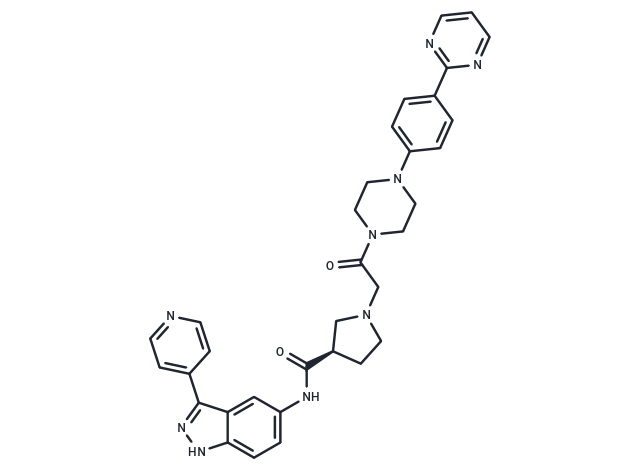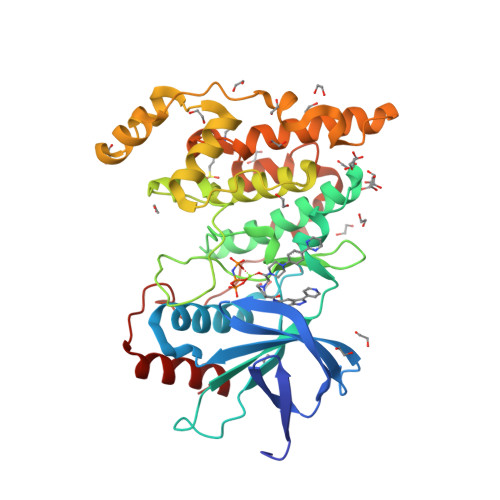 您的购物车当前为空
您的购物车当前为空
SCH772984
一键复制产品信息SCH772984 是一种 ERK 抑制剂,抑制 ERK1 和 ERK2 (IC50=4/1 nM),具有高选择性和 ATP 竞争性。SCH772984 对 BRAF 或 RAS 突变细胞具有抗肿瘤活性。

SCH772984
一键复制产品信息SCH772984 是一种 ERK 抑制剂,抑制 ERK1 和 ERK2 (IC50=4/1 nM),具有高选择性和 ATP 竞争性。SCH772984 对 BRAF 或 RAS 突变细胞具有抗肿瘤活性。
| 规格 | 价格 | 库存 | 数量 |
|---|---|---|---|
| 1 mg | ¥ 553 | 现货 | |
| 2 mg | ¥ 806 | 现货 | |
| 5 mg | ¥ 1,090 | 现货 | |
| 10 mg | ¥ 1,580 | 现货 | |
| 25 mg | ¥ 2,730 | 现货 | |
| 50 mg | ¥ 3,960 | 现货 | |
| 100 mg | ¥ 5,630 | 现货 | |
| 200 mg | ¥ 7,450 | 现货 | |
| 1 mL x 10 mM (in DMSO) | ¥ 1,410 | 现货 |
产品介绍
| 产品描述 | SCH772984 is an ERK inhibitor that inhibits ERK1 and ERK2 (IC50=4/1 nM) and is highly selective and ATP-competitive. SCH772984 exhibits antitumor activity against BRAF or RAS mutant cells. |
| 靶点活性 | ERK2:1 nM (cell free), H727 cells:115 nM, HCT116 cells:50 nM, ERK1:4 nM (cell free), SH-SY5Y cells:50 nM, U-937 cells:1.7 µM |
| 体外活性 | 方法: 21 种含有BRAF基因突变的黑色素瘤细胞系用 SCH772984 (0-10 µM) 处理 72-120 h,使用 CellTiter-Glo Luminescent Cell Viability Assay 检测细胞活力。 |
| 体内活性 | 方法: 为检测体内抗肿瘤活性,将 SCH772984 (25-50 mg/kg) 腹腔注射给携带 MiaPaCa 异种移植物的 Nude 小鼠,每天两次,持续十四天。 |
| 激酶实验 | SCH772984 was tested in 8-point dilution curves in duplicate against purified ERK1 or ERK2. The enzyme was added to the reaction plate and incubated with the compound before adding a solution of substrate peptide and ATP. Fourteen microliters of diluted enzyme (0.3 ng active ERK2 per reaction) was added to each well of a 384-well plate. The plates were gently shaken to mix the reagents and incubated for 45 minutes at room temperature. The reaction was stopped with 60 μL of IMAP Binding Solution (1:2,200 dilutions of IMAP beads in 1× binding buffer). The plates were incubated at room temperature for an additional 0.5 hours to allow complete binding of phosphopeptides to the IMAP beads. Plates were read on the LJL Analyst [1]. |
| 细胞实验 | For resistant cell line creation, cells were grown in Dulbecco's modified Eagle medium with 10% heat-inactivated FBS media and increasing concentrations of inhibitor (PLX4032, 0.1–10 μmol/L; GSK1120212, 0.01–1 μmol/L) over approximately 4 to 8 months until resistant cells acquired growth properties similar to na?ve parental cells (at their top drug concentrations). For combination resistance, cells were incubated as above but with alternative dose escalation until a top concentration was acquired (PLX4032 10 μmol/L and GSK1120212 1 μmol/L). Stocks and dilutions of PLX4032, GSK1120212, and SCH772984 were made in DMSO solvent. Cell proliferation experiments were carried out in a 96-well format (six replicates), and cells were plated at a density of 4,000 cells per well. At 24 hours after cell seeding, cells were treated with DMSO or a 9-point IC50 dilution (0.001–10 μmol/L) at a final concentration of 1% DMSO for all concentrations. Viability was assayed 5 days after dosing using the ViaLight luminescence kit following the manufacturer's recommendations (n = 6, mean ± SE). For the cell line panel viability assay, cells were treated with SCH772984 for 4 days and assayed by the CellTiterGlo luminescent cell viability assay. For IncuCyte analysis, cells were plated as above in 96-well plates, and image-based cell confluence data were collected every 2 hours during live growth. For engineered resistant lines, cells were infected with lentivirus produced from lentiORF constructs expressing either RFP, KRASG13D, BRAFV600E, truncated BRAFV600E lacking exons 2–8 (Δ2-8), MEK1P124L, MEK1F129L, or constitutively active MEK1DD (S218D+S222D). Cells were selected in blasticidin (20 μg/mL) and used for ViaLight assays as described above [1]. |
| 动物实验 | Nude mice were injected subcutaneously with specific cell lines, grown to approximately 100 mm^3, randomized to treatment groups (10 mice/group), and treated intraperitoneally with either SCH772984 or vehicle according to the dosing schedule indicated in the figure legends. Tumor length (L), width (W), and height (H) were measured during and after the treatment periods by a caliper twice weekly on each mouse and then used to calculate tumor volume using the formula (L × W × H)/2. Animal body weights were measured on the same days twice weekly. Data were expressed as mean ± SEM. Upon completion of the experiment, vehicle- and SCH772984-treated tumor biopsies were processed for Western blot analysis [1]. |
| 分子量 | 587.67 |
| 分子式 | C33H33N9O2 |
| CAS No. | 942183-80-4 |
| Smiles | O=C(CN1CC[C@H](C1)C(=O)Nc1ccc2[nH]nc(-c3ccncc3)c2c1)N1CCN(CC1)c1ccc(cc1)-c1ncccn1 |
| 密度 | 1.353 g/cm3 at 20℃ |
| 颜色 | Yellow |
| 物理性状 | Solid |
| 存储 | store at low temperature | Powder: -20°C for 3 years | In solvent: -80°C for 1 year | Shipping with blue ice/Shipping at ambient temperature. | |||||||||||||||||||||||||
| 溶解度信息 | H2O: < 1 mg/mL (insoluble or slightly soluble) Ethanol: < 1 mg/mL (insoluble or slightly soluble) DMSO: 16.7 mg/mL (28.42 mM), Sonication is recommended. | |||||||||||||||||||||||||
| 体内实验配方 | 10% DMSO+90% Saline: 0.54 mg/mL (0.92 mM), Solution. 请按顺序添加溶剂,在添加下一种溶剂之前,尽可能使溶液澄清。如有必要,可通过加热、超声、涡旋处理进行溶解。工作液建议现配现用。以上配方仅供参考,体内配方并不是绝对的,请根据不同情况进行调整。 | |||||||||||||||||||||||||
溶液配制表 | ||||||||||||||||||||||||||
DMSO
| ||||||||||||||||||||||||||
 化合物与蛋白结合的复合物
化合物与蛋白结合的复合物

Structure of human haspin (GSG2) in complex with SCH772984 revealing the first type-I binding mode
计算器
体内实验配液计算器
以上为“体内实验配液计算器”的使用方法举例,并不是具体某个化合物的推荐配制方式,请根据您的实验动物和给药方式选择适当的溶解方案。
剂量转换
对于不同动物的给药剂量换算,您也可以参考 更多




 很棒
很棒
 |
|